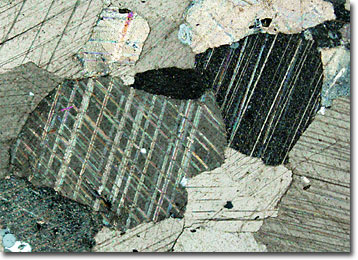Polarized Light Microscopy Digital Image Gallery
Pink Marble
Strictly speaking, marble is a metamorphic rock chiefly composed of granular limestone or dolomite, which has developed a crystalline structure due to the influence of various outside influences, most notably pressure and heat. However, the term is often applied to any attractive, easily polished rock that is rich in calcium.

The marble most popular among ancient Greek sculptors and many subsequent artists, such as the famous Michelangelo, is pure white in color. However, marble may also display a variety of color variegations that can impart a pink, yellow, gray, green, blue, red, black, or buff hue to the material. These characteristic swirls or bands of color, which appear from impurities in the rock, are usually believed to only add to the beauty of marble. Thus, numerous buildings and ornamental structures also utilize these varieties of the rock, although typically indoors because marble can be readily corroded by the elements and impurities further diminish its durability.
Marble quarries can be found in a great number of locations around the world. A beautiful pink calcite marble, for instance, is quarried in Canada near Madoc, Ontario. High quality white and gray marbles are mined, on the other hand, in Alabama, Georgia, Vermont, and in a number of other locales, while the Tuscany region of Italy supplies a reddish marble and the quarry near Mexico City is better known for a brown or yellow marble. Also, shell-containing bluish, gray, or green limestone marbles, which were quite popular during the medieval period, are found in England and are well known for their use in the construction of Westminster Abbey and a number of other stunning cathedrals.
